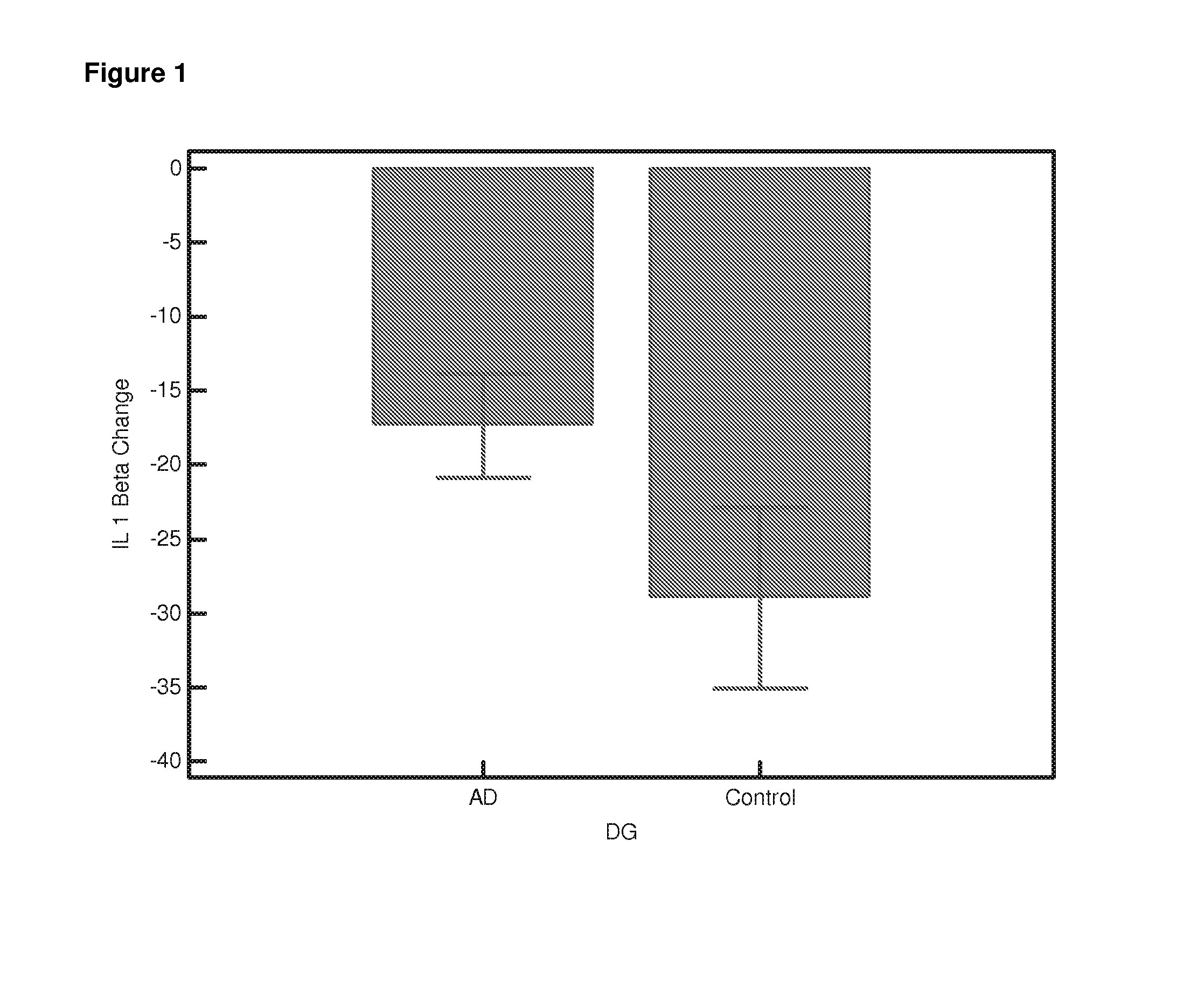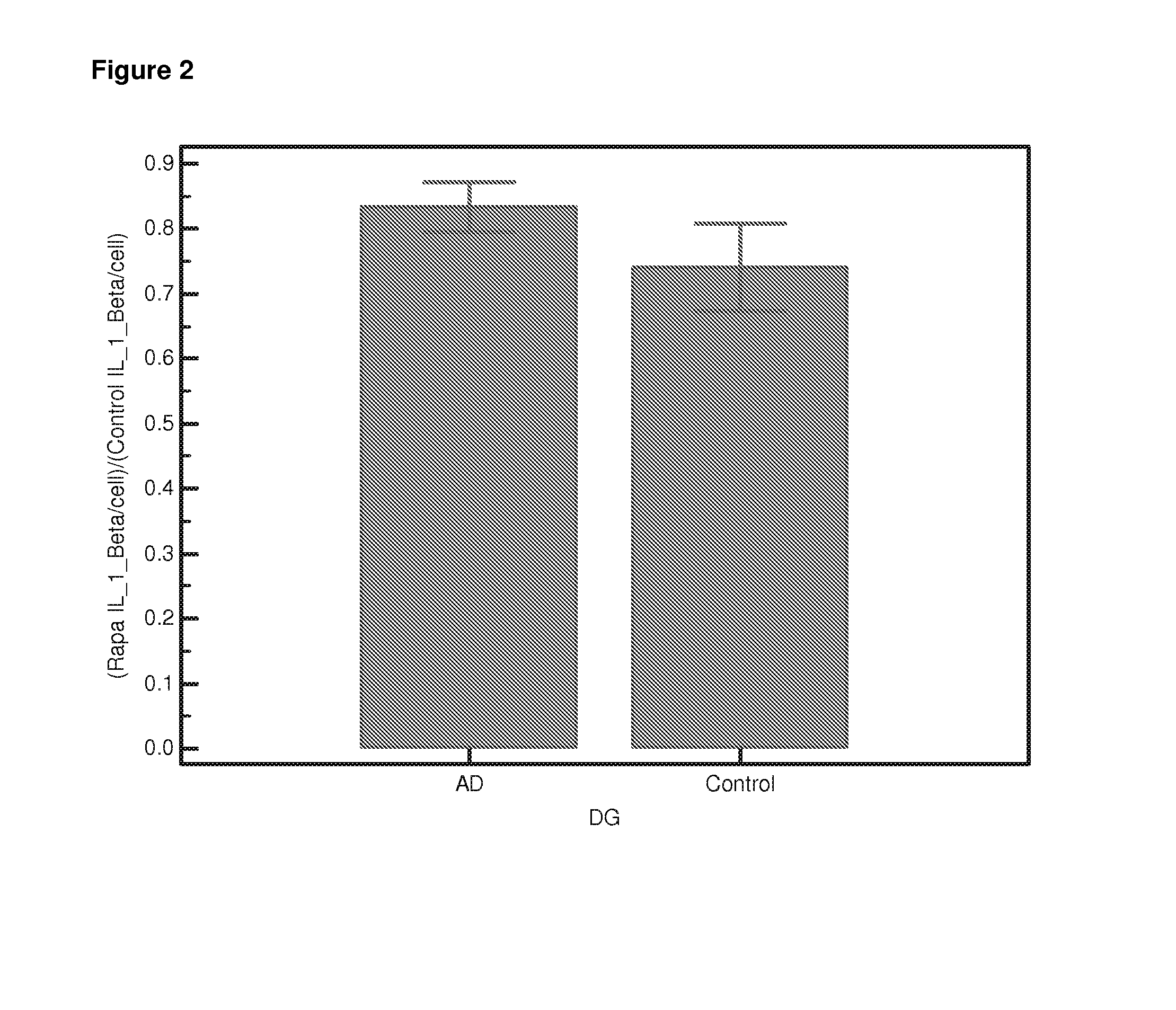Diagnosis for Alzheimer's Disease
a technology for alzheimer's and diagnosis, applied in the direction of instruments, biochemistry apparatus and processes, material analysis, etc., can solve the problems of dementia in affected individuals, no acceptance, and cognitive impairmen
- Summary
- Abstract
- Description
- Claims
- Application Information
AI Technical Summary
Benefits of technology
Problems solved by technology
Method used
Image
Examples
example 1
Gene Expression Microarray Analysis of Lymphocytes Treated with Rapamycin
[0125]Two-colour microarray based gene expression analysis (Agilent Technologies) was used to identify genes that were differentially expressed in lymphocytes treated with rapamycin compared to lymphocytes that were left untreated. The microarray used was the Agilent Whole Human Genome Microarray: 4×44K.
1.1 Lymphocyte Culture with and without Rapamycin
[0126]Two parallel lymphocyte cultures were set up in RPMI medium supplemented with 10% FCS at a concentration of 1×106 cells per 1 ml of culture media. Phytohaemaglutinin (PHA) was added to the cultures at a final concentration of 22 μg / ml to activate the lymphocytes. Cultures were incubated for 48 hours at 37° C. in a humidified atmosphere containing 5% CO2. After 48 hours culture, one culture was treated with 100 ng / ml rapamycin, while the other untreated culture was kept as a control. After a further 24 hours, the cells of each lymphocyte culture were harveste...
example 2
Expression Analysis of Rapamycin-Sensitive Genes in Lymphocytes Isolated from Human Subjects
[0136]Lymphocytes are isolated from venous blood samples collected from the human subjects for testing. The venous blood sample is collected from the patient in a heparin vacutainer and transported into the laboratory at room temperature within 48 hours. The lymphocytes are separated from the blood according to standard protocols using Lymphoprep, Histopaque, Ficoll or an equivalent standard reagent.
[0137]Alternatively, the venous blood is collected directly into a BD Vacutainer® CPT™ cell preparation tube with sodium heparin and lymphocyte separation is carried out, using one of the techniques described above, instantly. The lymphocyte sample is then transported to the laboratory for analysis.
[0138]For each lymphocyte sample taken from a human subject, two parallel lymphocyte cultures are set up in RPMI medium supplemented with 10% FCS at a concentration of 1×106 cells per 1 ml of culture me...
example 3
Differential Gene Expression Responses to Rapamycin Measured in Alzheimer's Disease Patients
3.1 Blood Collection and Lymphocyte Separation
[0140]Peripheral blood samples from elderly subjects were provided by the Oxford Project to Investigate Memory and Ageing (OPTIMA) subject to ethical approval and informed patient and carer consent. The samples provided were from Alzheimer patients who fulfilled the NINCDS-ARDRA criteria for probable AD (n=24) or from healthy age-matched controls (n=21). Appropriate consent and ethical approval was sought before the study began.
[0141]Peripheral blood was collected in Heparin vacutainers and shipped at room temperature. The separation of lymphocytes was carried out within 24 hours of blood collection using established protocols [Lymphoprep]. Briefly the blood was diluted 1:1 with PBS (Ca and Mg free, Sigma). Ten ml diluted blood was carefully layered onto 4 ml Lymphoprep (Axis Shield UK) in 15-ml conical centrifuge tubes. Samples were centrifuged a...
PUM
| Property | Measurement | Unit |
|---|---|---|
| concentration | aaaaa | aaaaa |
| volume | aaaaa | aaaaa |
| volume | aaaaa | aaaaa |
Abstract
Description
Claims
Application Information
 Login to View More
Login to View More - R&D
- Intellectual Property
- Life Sciences
- Materials
- Tech Scout
- Unparalleled Data Quality
- Higher Quality Content
- 60% Fewer Hallucinations
Browse by: Latest US Patents, China's latest patents, Technical Efficacy Thesaurus, Application Domain, Technology Topic, Popular Technical Reports.
© 2025 PatSnap. All rights reserved.Legal|Privacy policy|Modern Slavery Act Transparency Statement|Sitemap|About US| Contact US: help@patsnap.com



